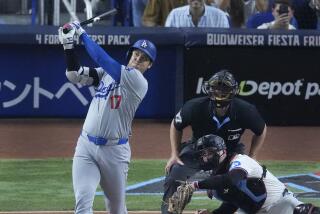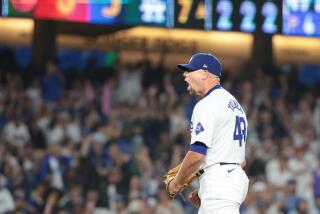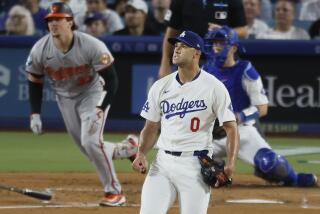Sammyās Only So-So With Orioles
BALTIMORE ā Ordinary comes in batting stances open in the first inning, closed in the fourth and square in the sixth.
Ordinary finds one in the fourth place in the order, then the second, then fifth, then the sixth, over four months.
It is batting practice early, long walks from the clubhouse late, aggravation in between.
Sammy Sosa is on a stool, a bat in his fingers, shoulders rolled forward. It is a Friday night, and the humidity that drifts from the dugout and along the walls of a corridor shows as sweat on his forehead and cheeks.
One of the great home run hitters in baseball history has turned 36. He hits his home runs now once every 25 at-bats, through 319 of them as a Baltimore Oriole. He is batting .235, .229 with runners on base, and has driven in 15 runs since June 13.
Time was, Sosa ran at-bats like George Steinbrenner runs interns. From shoulder to ball, his bat barrel was as fast as it was loud. Now, it is the pitchers who work Sosa, hard in, hard up, soft away and down.
And thatās when Sammy Sosa became ordinary.
In a 17-year career, he has 587 home runs, 408 in an eight-year period in which he, Mark McGwire and Barry Bonds drove the age of the long ball, distracted a baseball public made dispassionate by the 1994 work stoppage and pushed the game -- revenue, ratings, attendance -- to the point Commissioner Bud Selig once called it a āgolden era.ā President Bush warmed audiences with self-effacing jokes about being the man who traded Sammy Sosa.
While Selig might still believe it to be golden, that era spilled into a congressional steroid investigation, suddenly frantic attempts to invoke a stronger testing program for performance-enhancing drugs and a wary-again public.
Of the heroes of a home run generation, McGwire retired, Bonds has sat out this season because of knee injuries and Sosa was traded from Chicago to Baltimore, where he struggles to live up to the standards of his game.
When he bunched three home runs in four games last week, there were hopes at Camden Yards that he had retaken the uncanny stroke of his prime. But he was again ordinary in the long weekend that followed, including three strikeouts in a nationally televised game Sunday night, when he batted sixth.
āEvery player has to go through that situation,ā Sosa said of his four-month slump. āNo one in this game gets it for free. Sooner or later, youāre going to go through it.ā
Sosa speaks softly. Impatiently. He agrees to an interview he has no time for, no taste for. He has five minutes, enough for a few questions as acquaintances from the Chicago White Sox stroll by. He jumps up and shares hugs and greetings with former teammates, or men who once played in his long shadow across town with the Cubs. When they are gone, his eyes dim again, his posture falls again, and he explains again that this is temporary, this slump, this thing that has settled into his every day.
āYou just have to deal with it,ā he said, by āyouā meaning āI.ā āWhat can you do?ā
Sosa was, at first, the symbol of the new Orioles, winners of one American League East title since 1983. He flew in with a massive smile set atop broad shoulders and thick forearms. He courted Oriole fans, who a few years before had lost Cal Ripken Jr., with a personality that, when engaged, can hoist the spirit of an entire season.
When he burst from the dugout, dashed in a wide arc toward right field, waving, pointing, encouraging, the people here just knew they would love Sammy Sosa. That they boo him now, lightly when the batting order is introduced, louder when he trudges from battersā box to dugout, bat flicking in his right hand, speaks to their expectations, and how far he is from meeting them.
For Sosa remains a symbol, but now for the losing that has turned the Orioles from a surprise first-place team as recently as June 23, ahead of the favored Boston Red Sox and New York Yankees, to a fourth-place disappointment, behind the Red Sox, Yankees and even the Toronto Blue Jays.
āThis game is not only for one guy,ā he snapped. āSo, forget about that. I know Iām going to do my part.ā
Injuries to critical players -- starting pitcher Erik Bedard, catcher Javy Lopez, and, for a short time, to Sosa himself -- have helped wreck the Orioles. All-Star second baseman Brian Roberts has endured a difficult second half. Rafael Palmeiro started slowly before regaining a swing that three weeks ago produced the 3,000th hit of his career, and now heās serving a 10-day suspension after testing positive for a performance-enhancing drug. Even Miguel Tejada, an MVP candidate again, has suffered through fallow periods.
Together, it means the Orioles arrived in Anaheim on Tuesday night having lost 14 of 16 games, and six more games in the standings in the last week and a half, and the faith of a fan base that no longer fills their ballpark.
It is Sosa, the superstar and one of the icons of a generation of baseball, who appears to possess the greatest burden. When his 13th home run allowed him to pass Frank Robinson and move into fifth place on the all-time list, he reluctantly discussed the achievement, or refused entirely. It speaks perhaps to his ferocious aspiration to hit again, the elimination of superfluous thoughts and the emotional grind of the slump itself.
āItās hard for anybody,ā Tejada said, āto not have the season he really wanted to have.ā
His teammates and manager defend him. They say he will become great any at-bat now.
āWe donāt have to worry about him,ā third baseman Melvin Mora said. āHe knows how to get rid of that. He knows what he needs to do to get better.ā
Palmeiro, who will be 41 in September and has hit 569 home runs himself, insisted Sosa remains, ācapable of doing some great things.ā
āHeās an incredible presence in the lineup,ā he said. āIf he were to get hot, as he has in the past, heās capable of carrying the team as a whole.
āYou get older. You slow down. Itās not the same. I donāt think heās there yet, but heās the only one who can answer that.ā
So, the hitting coach slides Sosaās front foot around, and the manager looks for a comfortable place in the order for him, and the scouts observe a slower bat. Heās gaining on 40. Heās in a league he hadnāt seen every day since 1991. And, lately, heās so conscious of inside fastballs his back foot is practically in the on-deck circle.
Maybe itās time.
McGwire hit 65 home runs in 1999, battled injuries and hit 61 home runs over the next two seasons, and retired. Bonds hit 45 home runs a year ago, had a few knee surgeries, and probably wonāt play again until next season, if at all.
Sosa, traded in the off-season for Jerry Hairston, Dave Crouthers and Mike Fontenot, is in the final year of his contract. Heāll make $25 million, the Orioles paying $9 million of it. Then, itās hard to tell. Sosa has said he intends to continue on. The Orioles will wait and see, decide what a designated hitter who hits .235 and ranks 69th in the American League in on-base plus slugging percentages is worth.
āIām not thinking about that,ā Sosa said. āThis is a great place. A beautiful place. I came here because they opened the doors for me. This is a place I want to finish my career. I donāt want to be jumping all around.ā
He has two months. The team is crumbling with him. Jumping is perhaps what he has left.
Meanwhile, the sweat has found its way to Sosaās neck, and he is standing, eager to go. Slumps and humidity work equally well on a manās anxiety, and the next at-bat is only an hour or so away. He holds his bat by the barrel and hoists it to his hip. If he is going to be ordinary, heāll go be ordinary in the batting cage for a while.
āIām all right,ā he says. āIāll survive.ā
*
(BEGIN TEXT OF INFOBOX)
Top of their game
Active career home run leaders (through Tuesday):
Barry Bonds...703
Sammy Sosa...587
Rafael Palmeiro...569
Ken Griffey...524
Jeff Bagwell...449
Frank Thomas...448
Gary Sheffield...436
Juan Gonzalez...434
Jim Thome...430
Manny Ramirez...419
More to Read
Go beyond the scoreboard
Get the latest on L.A.'s teams in the daily Sports Report newsletter.
You may occasionally receive promotional content from the Los Angeles Times.










